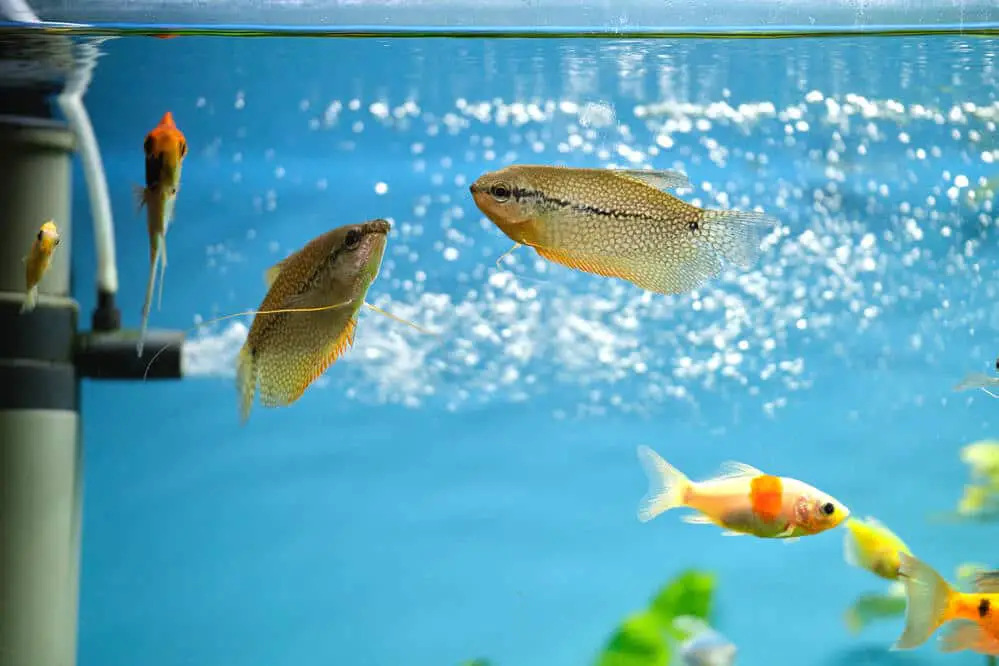Tank cruising, glass surfing, fishbowl pacing and aquarium gliding. These are all catchphrases professional and hobbyist aquarists use to describe how their fish traverse the tank. While this is normal behavior for some species of finned friends, it may be cause for concern with others.
In this article, we’ll discuss the top 7 reasons why your fish swims up and down in the tank. These include inclement water parameters, inappropriate tank mates, loneliness, poor aquarium size, overstocked tank, feeding and disease. While there are many other possibilities, these are usually the most common.
Remember, though, if you see your fish swimming up and down in the tank, it’s usually not going to be anything serious. The only time you should observe and take on worry is when you see them not eating, not in the areas of the tank they don’t usually frequent or if they appear ill in some way.

Author’s Special Note: Moreover, some fish, like the Cory Catfish have the habit of moving up and down in the tank for breathing. They quickly dart towards the water surface, take a gulp of air and quickly return back. Read this quick guide to know more about Cory Catfish breathing. They keep doing this once in a while – so you don’t need to be worried if that’s the case. As long as your fish is not in stress, everything should be okay.
1. Inappropriate Water Parameters
It is essential that you keep to a good aquarium maintenance schedule. And this doesn’t just mean performing regular water changes but also to clean off equipment like filters and water pumps.
Waste, excess food, dead fish and poor water circulation can all contribute to poor water conditions.
If there’s a strong presence of algae or a snail infestation in the tank, it’s going to make your fish swim around more. Also, when they have a hard time getting enough oxygen in the tank, they’ll more likely go toward the top of the tank.
Of course, this will also rely on how you introduced the fish into the tank. A big mistake most newcomers make with their aquarium is not cycling the water ahead of time. Establishing the nitrogen cycle is incredibly important and it will affect your fish if not done correctly.
A Brief Checklist
So, use the points mentioned below as a checklist:
- Use a quality water test to make sure all the levels are appropriate for your fish
- Do a 10% to 25% water change at least once or twice per month to keep things clean and fresh
- Profuse algae growth or a sudden snail outbreak means you’ll have to clean the tank and its equipment
- Make sure there’s enough oxygenation in the tank along with the appropriate temperature
2. Incompatible Tank Mates
Another major cause for fish to glass surf unnecessarily is the stress experienced from living with inappropriate tank mates. This means you must do thorough research on the kinds of fish you want to house together. Fin nipping, chasing and other bully tactics are common for many fish to do.
You want to make sure they’re not only right for each other, but that they’ll also get along. For example, if you have a fish that likes to hang out in the middle of the tank most of the time, then you should have tank mates that are bottom feeders or those who are usually very peaceful.
Study Up on Your Fish
The key here is to amass as much information as you can about the finned friends you wish to house. Any misstep in this regard can spell disaster later on. Even still, you can do all the research and make all the right decisions but your fish may still bully each other.
When you notice a tank bully, you have to remove them from the rest of your fish. It may just be that they want to be alone. This means setting up its own tank away from the main one.
3. Loneliness
While some fish prefer to be by their lonesome in an aquatic environment, other species will not do well. If you have a single fish that usually likes to be part of a school, depression will make it frantic and result in the poor thing swimming up and down the tank.
Always make sure you house the minimum number of fish a species likes to be around. At the same time, you want to ensure that you don’t add too many of them so as to prevent stress for other tank mates. Loneliness in fish, if prolonged, can create perpetual stress that will end in lowered immunity and disease.
To know more about loneliness in fish please check out this detailed article where I explain it in detail.
4. Poor Aquarium Size
Another common problem for newbie aquarists is that they don’t have the right aquarium size for all the fish they house. This is especially true for a community aquascape with varying sizes of fish. On average, estimate one gallon for every three inches of fish.
While you should do research on your specific species, the guide below indicates the average number of fish and the size tank most appropriate for them. Of course, the size of the fish will be a great determining factor:
| Tank Size | Number of Fish |
| 5 | 4 to 6 |
| 10 | 5 to 7 |
| 15 | No more than 10 |
| 20 | 10 to 15 |
| 30 | 15 to 20 |
| 50 | 20 to 30 |
5. Overstocked Tank
An overstocked tank relates to the point above. However, it deserves its own mention to drive the point home about having an appropriate tank size. In some cases, you may start out with the right number of fish perfect for the size of the aquarium, but baby fish may begin appearing.
In this way, an aquascape can easily be overrun with fish, making it cramped and overstocked. This will inevitably lead to fish swimming in an erratic way. If this happens, you must set up another tank to make things comfortable, clean and appropriate.
In some cases, you may be able to sell your fish to other fish keepers looking for new additions to their aquascape. When all else fails, you may have to choose to terminate some of them for the sake of the aquarium. But, this should be a last ditch effort.
Check out this guide to learn how many fish you should at once in the tank.
6. Overfeeding or Poor Food Quality
A contributor to fishbowl pacing is when you overfeed fish or provide food they don’t find scrumptious. Overfeeding means more waste left to decompose in the water, which will not only mess with the parameters (as mentioned earlier) but it will also make your fish sick. This can cause your fish to swim throughout the tank.
Also, never feed your fish more than what each can eat in a span of a few seconds. If they don’t eat what you offer immediately, you’re giving them too much food. Remove any leftovers as quickly as possible to help maintain balance in the tank’s water parameters.
Likewise, if your fish isn’t eating the food you provide and they swim up and down in the tank, then it’s possible you’re offering poor quality food. Try a variety of foods that include flakes, pellets, etc to see what they like best.
7. Disease
If you know the above points are not causing your fish to engage in aquarium gliding, then it could be there’s an underlying health condition. To suspect this, your fish must be swimming in strange patterns that you know is not their normal mode of behavior.
Also, there will be a sickly appearance to your fish. This can include white spots, frayed fins and dulled discoloration. Such signs will also accompany things like a lack of appetite, lethargy and panting. When in doubt, always call your vet and ask them their opinion on the matter.
Diagnosis ; Treatment
Diagnosing the problem is somewhat difficult. It could be an injury, a parasite, water abnormalities or genetics. However, the fish could be suffering from ich, gill flukes, anchor worms or bloating. If you notice any of these symptoms, check the other fish in your tank as well to see if they are also ill.
Regardless of what it could be, you will have to act fast. This means setting up a quarantine tank right away and removing the fish from the environment. However, if all your fish in the tank are experiencing some kind of disease, you can keep them in the main tank.
Make sure the water is clean and pristine with the right amount of oxygenation and cycling. Check the temperature and ensure it’s optimal for their happiness. You may have to put some medication into the water like copper or an antibiotic to remove the problem from the surrounding area.
Wrapping Up
Remember, speak with your aquatic vet if you have any doubt about why your fish is swimming up and down in the tank. They will have the tips, tricks and resources along with the right suggestions for medication. Even still, there may be nothing to worry about since most fish traverse the expanse of their habitat.
The only time you should have reason for alarm is when your fish appear as though they don’t feel well. This will accompany signs like discoloration, heavy breathing, lethargy, white spots, etc. So, just observe your fish with a keen eye and set up a quarantine tank if necessary.
Hi! I’m Praveen Ghoshal, the founder of eFishkeeping.com. Inspired by my Dad, I got interested in fishkeeping when I was a kid. Since then, I have been involved with this hobby. Currently, I have 3 fish tanks at our home, and I enjoy this hobby with my full family. Read more about me here.






![Do Neon Tetras Die Easily? [Here’s The Truth!] do-neon-tetras-die-easily](https://efishkeeping.com/wp-content/uploads/2023/03/do-neon-tetras-die-easily-300x200.jpg)
